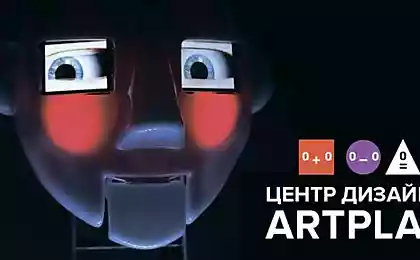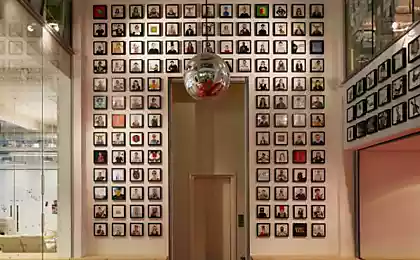917
What thinks the severed head of a man?
For centuries, people wondered whether or not a man's severed head to maintain consciousness and thought. Modern experiments on mammals and numerous eyewitness accounts provide a wealth of material for debate and discussion.
7 photo. A source.

Decapitation in Europe
The tradition of beheading has deep roots in the history and culture of many nations. For example, in one of the deuterocanonical books of the Bible tells the famous story of Judith, the beautiful La Juive that fraud has penetrated into the camp of the Assyrians besieging her hometown and had crept into the confidence of the enemy warlord Holofernes, cut off his head at night.
In the biggest European countries decapitation was considered one of the most precious species of executions. The ancient Romans used it in relation to its citizens, since the process of decapitation is quick and not so painful as crucifixion suffered by criminals without Roman citizenship.
In medieval Europe, the beheading as enjoyed a special honor. Head cut off only the nobles; peasants and artisans hanged and drowned.
Only in the XX century it has been recognized by decapitation Western civilization inhumane and barbaric. Currently Beheading as capital punishment is applied only in the Middle East: Qatar, Saudi Arabia, Yemen and Iran.
Judith and Holofernes
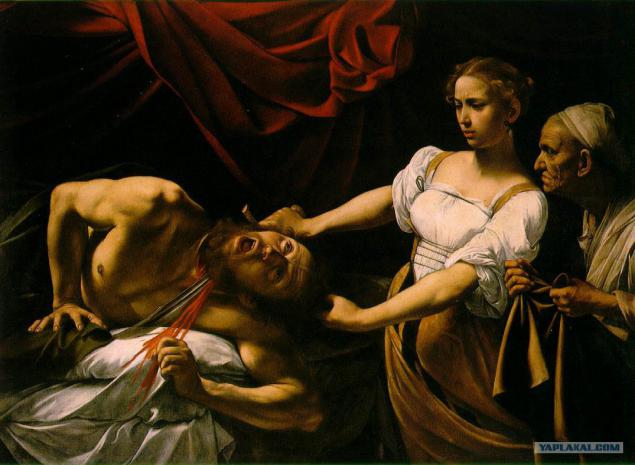
The history of the guillotine
The heads are usually cut off with axes and swords. Thus, if in certain countries, such as Saudi Arabia, the torturers were trained is always, in the Middle Ages for the enforcement of the sentence is often used simply guards and craftsmen. As a result, in many cases, cut off the head from the first failed, which led to terrible tortures and sentenced indignation crowd of onlookers.
So at the end of the XVIII century as an alternative and more humane tools penalty was first introduced the guillotine. Contrary to popular belief, this tool gets its name is not in honor of its inventor - Antun surgeon Louis.
Godfather machine of death was Joseph Ignace Guillotin, a professor of anatomy, for the first time proposed to use for the beheading of a mechanism that, in his opinion, would not cause more pain convicted.
The first sentence using the terrible news was carried out in 1792 in the post-revolutionary France. Guillotine actually allowed to turn in at the death of the human conveyor; Thanks to her in just one year Jacobin executioners executed more than 30 000 French citizens, staged a real terror to his people.
However, a couple of years later, a machine for beheading a reception arranged by the Jacobins under the cheers and hoots of the crowd. France used the guillotine as the death penalty until 1977, when his head was cut off last in the European territory.
The guillotine was used in Europe until 1977
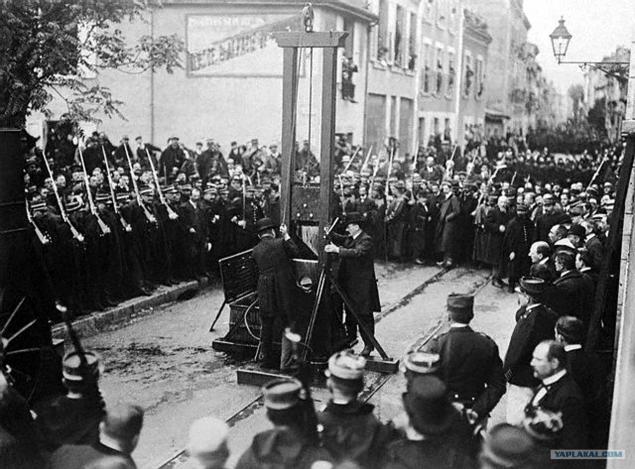
But what happens during the decapitation in terms of physiology?
As is known, the cardiovascular system through arterial blood carries oxygen and other essential substances to the brain required for its normal operation. Decapitation interrupts a closed circulatory system, blood pressure drops rapidly, depriving the brain of fresh blood. Suddenly deprived of oxygen the brain quickly ceases to function.
The time during which the head is executed in this case may remain conscious, it depends largely on the method of execution. If clumsy executioner took several blows to separate the head from the body, blood flows from arteries before the end of the penalty - a severed head was already long dead.
The head of Charlotte Corday
But the guillotine was the perfect instrument of death, the knife cut her neck with lightning speed, and the criminal very accurately. In post-revolutionary France, where the executions took place in public, often the executioner raised his head, had fallen to cart bran, and showed her mocking the crowd of onlookers.
For example, in 1793 after the execution of Charlotte Corday, who stabbed one of the leaders of the French Revolution, Jean-Paul Marat, according to eyewitnesses, the executioner, taking the severed head by the hair, mockingly whipped her cheeks. Much to the amazement of the audience face Charlotte flushed, and his features twisted into a grimace of anger.
Thus it was produced the first documentary account of eyewitnesses that the guillotine severed head of a man able to maintain consciousness. But not the last.
Scene of the murder of Marat by Charlotte Corday

What explains the grimaces on his face?
The debate about whether the human brain is able to continue to think after a Beheading, lasted many decades. Some believed that the faces, pretending that the person executed, usually explained by spasm of the muscles that control the movement of the lips and eyes. These spasms are often observed in other severed human limbs.
The difference is that unlike the arms and legs in the head is the brain thought center capable of consciously control the movements of the muscles. When beheading, in principle, any brain injury does not apply, so he is able to function as oxygen deficiency does not lead to loss of consciousness and death.
The severed head

There are many cases when, after the cutting head body chicken continues to move around the yard for a few seconds. Dutch researchers conducted studies on rats; They were still living as much as 4 seconds after decapitation.
Evidence of doctors and eyewitnesses
The idea that may be experiencing a severed head of a man, while remaining fully conscious, of course, terrible. Veteran US Army, who in 1989 together with a friend had a car accident, described the face of his companion, who shot off his head: "At first it expressed shock, then horror, and fear gave way at the end of sorrow ...»
According to eyewitnesses, the English King Charles I and Queen Anne Boleyn after the execution at the hands of the executioner moved his lips, trying to say something.
Strongly opposing the use of the guillotine, the German scientist Sömmerring referred to numerous medical records that the person executed curl in pain as his fingers touched the doctor cut the spinal canal.
The most famous of this type of evidence is from the pen of Dr. Borё who examined the head of an executed criminal Henri Languilla. The doctor says that within 25-30 seconds after decapitation, he twice called Languilla by name, and every time he opened his eyes and move his attention to Borё.
The mechanism for the enforcement of the death penalty by beheading
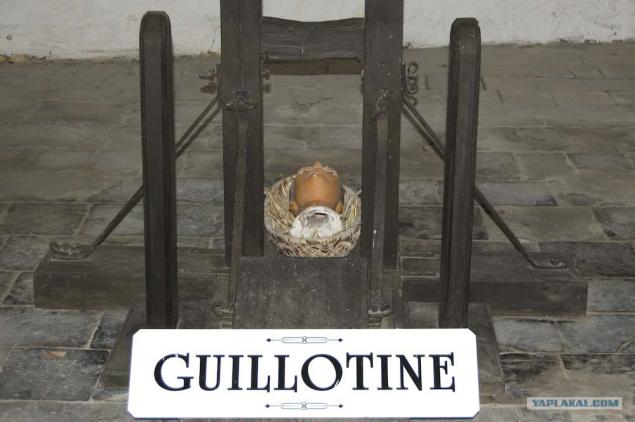
Conclusion
Eyewitness accounts and a number of experiments on animals show that after the beheading of a man can in a few seconds to keep the consciousness; he is able to listen, watch and react.
Fortunately, such information may be still useful only for researchers from some Arab countries, where the decapitation still popular as a legitimate capital punishment.

Source:
7 photo. A source.

Decapitation in Europe
The tradition of beheading has deep roots in the history and culture of many nations. For example, in one of the deuterocanonical books of the Bible tells the famous story of Judith, the beautiful La Juive that fraud has penetrated into the camp of the Assyrians besieging her hometown and had crept into the confidence of the enemy warlord Holofernes, cut off his head at night.
In the biggest European countries decapitation was considered one of the most precious species of executions. The ancient Romans used it in relation to its citizens, since the process of decapitation is quick and not so painful as crucifixion suffered by criminals without Roman citizenship.
In medieval Europe, the beheading as enjoyed a special honor. Head cut off only the nobles; peasants and artisans hanged and drowned.
Only in the XX century it has been recognized by decapitation Western civilization inhumane and barbaric. Currently Beheading as capital punishment is applied only in the Middle East: Qatar, Saudi Arabia, Yemen and Iran.
Judith and Holofernes

The history of the guillotine
The heads are usually cut off with axes and swords. Thus, if in certain countries, such as Saudi Arabia, the torturers were trained is always, in the Middle Ages for the enforcement of the sentence is often used simply guards and craftsmen. As a result, in many cases, cut off the head from the first failed, which led to terrible tortures and sentenced indignation crowd of onlookers.
So at the end of the XVIII century as an alternative and more humane tools penalty was first introduced the guillotine. Contrary to popular belief, this tool gets its name is not in honor of its inventor - Antun surgeon Louis.
Godfather machine of death was Joseph Ignace Guillotin, a professor of anatomy, for the first time proposed to use for the beheading of a mechanism that, in his opinion, would not cause more pain convicted.
The first sentence using the terrible news was carried out in 1792 in the post-revolutionary France. Guillotine actually allowed to turn in at the death of the human conveyor; Thanks to her in just one year Jacobin executioners executed more than 30 000 French citizens, staged a real terror to his people.
However, a couple of years later, a machine for beheading a reception arranged by the Jacobins under the cheers and hoots of the crowd. France used the guillotine as the death penalty until 1977, when his head was cut off last in the European territory.
The guillotine was used in Europe until 1977

But what happens during the decapitation in terms of physiology?
As is known, the cardiovascular system through arterial blood carries oxygen and other essential substances to the brain required for its normal operation. Decapitation interrupts a closed circulatory system, blood pressure drops rapidly, depriving the brain of fresh blood. Suddenly deprived of oxygen the brain quickly ceases to function.
The time during which the head is executed in this case may remain conscious, it depends largely on the method of execution. If clumsy executioner took several blows to separate the head from the body, blood flows from arteries before the end of the penalty - a severed head was already long dead.
The head of Charlotte Corday
But the guillotine was the perfect instrument of death, the knife cut her neck with lightning speed, and the criminal very accurately. In post-revolutionary France, where the executions took place in public, often the executioner raised his head, had fallen to cart bran, and showed her mocking the crowd of onlookers.
For example, in 1793 after the execution of Charlotte Corday, who stabbed one of the leaders of the French Revolution, Jean-Paul Marat, according to eyewitnesses, the executioner, taking the severed head by the hair, mockingly whipped her cheeks. Much to the amazement of the audience face Charlotte flushed, and his features twisted into a grimace of anger.
Thus it was produced the first documentary account of eyewitnesses that the guillotine severed head of a man able to maintain consciousness. But not the last.
Scene of the murder of Marat by Charlotte Corday

What explains the grimaces on his face?
The debate about whether the human brain is able to continue to think after a Beheading, lasted many decades. Some believed that the faces, pretending that the person executed, usually explained by spasm of the muscles that control the movement of the lips and eyes. These spasms are often observed in other severed human limbs.
The difference is that unlike the arms and legs in the head is the brain thought center capable of consciously control the movements of the muscles. When beheading, in principle, any brain injury does not apply, so he is able to function as oxygen deficiency does not lead to loss of consciousness and death.
The severed head

There are many cases when, after the cutting head body chicken continues to move around the yard for a few seconds. Dutch researchers conducted studies on rats; They were still living as much as 4 seconds after decapitation.
Evidence of doctors and eyewitnesses
The idea that may be experiencing a severed head of a man, while remaining fully conscious, of course, terrible. Veteran US Army, who in 1989 together with a friend had a car accident, described the face of his companion, who shot off his head: "At first it expressed shock, then horror, and fear gave way at the end of sorrow ...»
According to eyewitnesses, the English King Charles I and Queen Anne Boleyn after the execution at the hands of the executioner moved his lips, trying to say something.
Strongly opposing the use of the guillotine, the German scientist Sömmerring referred to numerous medical records that the person executed curl in pain as his fingers touched the doctor cut the spinal canal.
The most famous of this type of evidence is from the pen of Dr. Borё who examined the head of an executed criminal Henri Languilla. The doctor says that within 25-30 seconds after decapitation, he twice called Languilla by name, and every time he opened his eyes and move his attention to Borё.
The mechanism for the enforcement of the death penalty by beheading

Conclusion
Eyewitness accounts and a number of experiments on animals show that after the beheading of a man can in a few seconds to keep the consciousness; he is able to listen, watch and react.
Fortunately, such information may be still useful only for researchers from some Arab countries, where the decapitation still popular as a legitimate capital punishment.

Source:


















